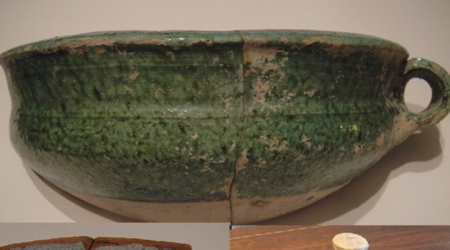- A-
- A
- A+
Archaeological studies continue in the ancient Albanian habitation - Galatepe

Mil-Karabakh expedition of ANAS Institute of Archeology and Ethnography continued archeological studies in the ancient and medieval city - Galatapa this summer.
A senior researcher of the Institute of Archaeology and Ethnography, head of Mil-Karabakh expedition group of Galatapa - Tavakkul Aliyev said that, investigations carried out here – in this ancient settlement with total area of 26 hectares, located in the plain Karabakh, territory of Agjabedi region, on the right bank of river Gargarchay, are carried out since 2008. Initially, cultural layer of 300 square meters with a thickness of 10 meters was studied. Here, were revealed the rubbles of a medieval brick building, a part of great defensive barriers made of bricks from the ancient era, and public buildings.
In order to explore in more detail the transition between the cultural layers of Galatepe, second excavation area was investigated. In 2013-2015, excavations were conducted here, in the 200 square meters of territory and a cultural layer with a thickness of 1.6 meters was studied.
This year, the other areas were spotlighted. Here, were uncovered building remains made of baked and raw bricks dated back Middle Ages, as well as farm wells, and oven facilities. The archaeological materials include glazed and unglazed pottery, stone tools, including glass and iron utensils. There, in the so-called territory - 1D square, in front of western wall - came across the undermining floor remains, which had been plastered twice at a depth of 1.2 meters, and three times in some parts. In the territory of 2D square were discovered a fireplace filled with ashes.
While cleaning around the fireplace, a black polished or mouth part of bucket-type pot and reddish body of the pot were reached from 1, 18-1, 2 meters depth. These examples are not attributed to the developed Middle Ages, but to the much earlier period - IV-VII centuries. There are no longer glazed ceramics are displayed on the floor below.
Studies carried out in Galatepe reaffirmed that, life in this settlement switched off after the attacks of Mongols. This can be clearly observed in the second cultural layer, locating 0,4-0,6 meters depth of excavation area: a large iron arrowhead, remaining intact boilers on the fire (there is also a cap on one), teapot and jug-type dish approves it.
Archaeologist said that ancient artefacts obtained from the necropolis Galatapa city place directly overlap with the period of Strabo, who informed about Albanian cities - Ayniana or Enian. This city was occurred still BC III-II centuries. During BC I – AD II, there was a busy life in the city, architecture, crafts, cultural-economic and trade relations via neighboring regions, including the provinces of the Roman Empire had been developed. Beginning of the third century Mil-Karabakh plain had become a battleground for Sassanian-Roman wars, in subsequent centuries Sasanian-Byzantine, Sassanian-Arab and Arab-Khazar wars, so the rhythm of life in ancient Ayniana (Enian) was violated.
In IX-X centuries - during the decline of the Caliphate, life revitalized in Galatapa city, but as a result of the XIII century Mongol invasions, ancient Albanian city Ayniana - Enian-Khankhan, which also named Greek in medieval ages, was declined drastically.
According to the archaeologist, the archaeological group of Galatapa conducted an exploration work in other areas of the Agjabadi region in 2016. Economical pitchers dated back to the early Iron Age were clarified in the vicinity of Minakhorlu village, in the riverbed Gargarchay. Uncovering the necropolis, consisting of pitcher graves, dated back Hellenistic period – BC III-I centuries, around the village Yeni Garadolag, is of great interest.
©All rights are reserved. Citing to www.science.gov.az is necessary upon using news.

 Elm TV
Elm TV
 Photo
Photo
 Video
Video









